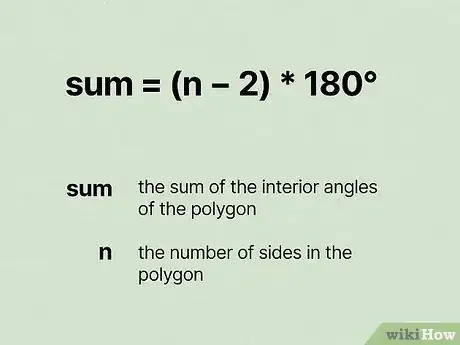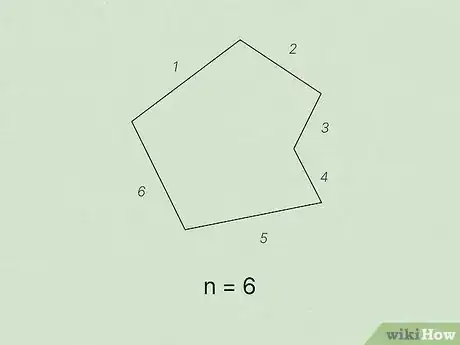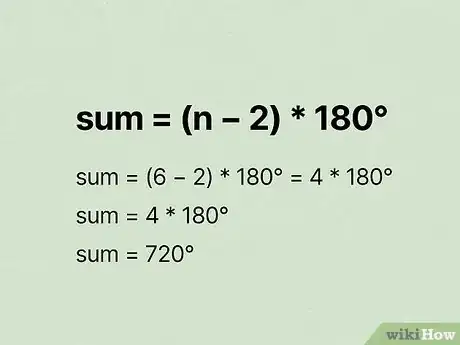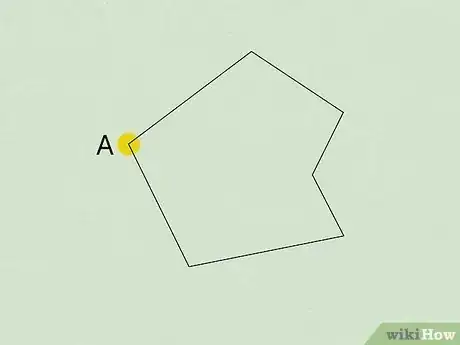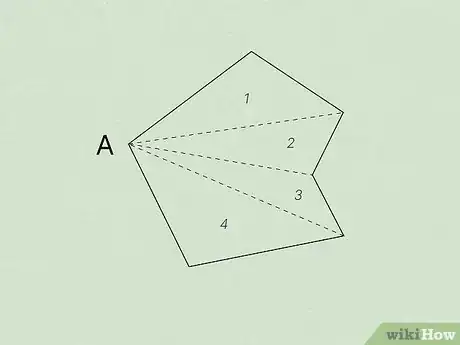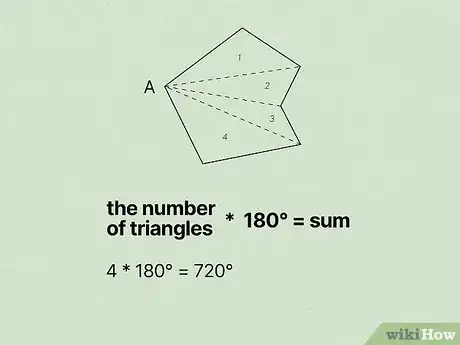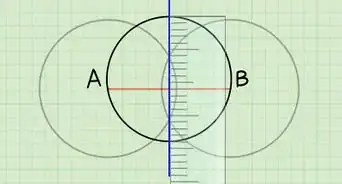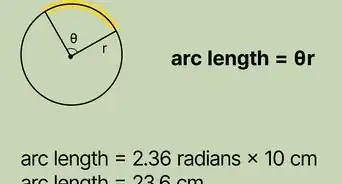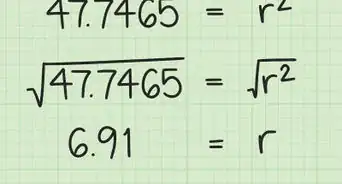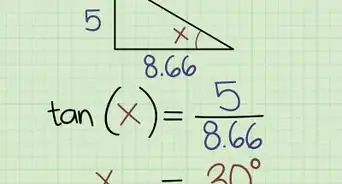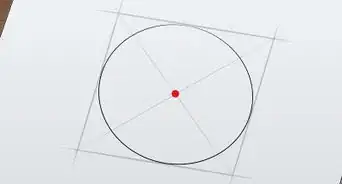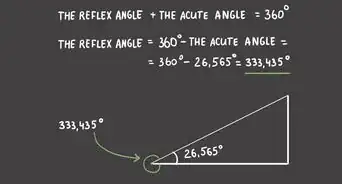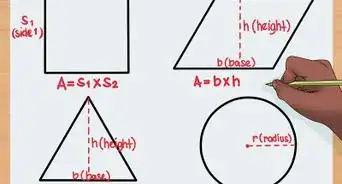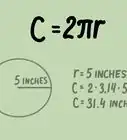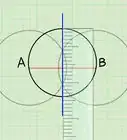This article was co-authored by David Jia. David Jia is an Academic Tutor and the Founder of LA Math Tutoring, a private tutoring company based in Los Angeles, California. With over 10 years of teaching experience, David works with students of all ages and grades in various subjects, as well as college admissions counseling and test preparation for the SAT, ACT, ISEE, and more. After attaining a perfect 800 math score and a 690 English score on the SAT, David was awarded the Dickinson Scholarship from the University of Miami, where he graduated with a Bachelor’s degree in Business Administration. Additionally, David has worked as an instructor for online videos for textbook companies such as Larson Texts, Big Ideas Learning, and Big Ideas Math.
This article has been viewed 378,644 times.
A polygon is any closed figure with sides made from straight lines. At each vertex of a polygon, there is both an interior and exterior angle, corresponding to the angles on the inside and outside of the closed figure. Understanding the relationships that govern these angles is useful in various geometrical problems. In particular, it is helpful to know how to calculate the sum of interior angles in a polygon. This can be done using a simple formula, or by dividing the polygon into triangles.
Steps
Using the Formula
-
1Set up the formula for finding the sum of the interior angles. The formula is , where is the sum of the interior angles of the polygon, and equals the number of sides in the polygon.[1] [2]
- The value 180 comes from how many degrees are in a triangle. The other part of the formula, is a way to determine how many triangles the polygon can be divided into. So, essentially the formula is calculating the degrees inside the triangles that make up the polygon.[3]
- This method will work whether you are working with a regular or irregular polygon. Regular and irregular polygons with the same number of sides will always have the same sum of interior angles, the difference only being that in a regular polygon, all interior angles have the same measurement.[4] In an irregular polygon, some of the angles will be smaller, some of the angles will be larger, but they will still add up to the same number of degrees that are in the regular shape.
-
2Count the number of sides in your polygon. Remember that a polygon must have at least three straight sides.[5]
- For example, if you want to know the sum of the interior angles of a hexagon, you would count 6 sides.
Advertisement -
3Plug the value of into the formula. Remember, is the number of sides in your polygon.[6]
- For example, if you are working with a hexagon, , since a hexagon has 6 sides. So, your formula should look like this:
- For example, if you are working with a hexagon, , since a hexagon has 6 sides. So, your formula should look like this:
-
4Solve for . To do this, subtract 2 from the number of sides, and multiply the difference by 180. This will give you, in degrees, the sum of the interior angles in your polygon.[7]
- For example, to find out the sum of the interior angles of a hexagon, you would calculate:
So, the sum of the interior angles of a hexagon is 720 degrees.
- For example, to find out the sum of the interior angles of a hexagon, you would calculate:
Drawing Triangles
-
1Draw the polygon whose angles you need to sum. The polygon can have any number of sides and can be regular or irregular.
- For example, you might want to find the sum of the interior angles of a hexagon, so you would draw a six-sided shape.
-
2Choose one vertex. Label this vertex A.
- A vertex is a point where two sides of a polygon meet.
-
3Draw a straight line from Point A to each other vertex in the polygon. The lines should not cross. You should create a number of triangles.
- You do not have to draw lines to the adjacent vertices, since they are already connected by a side.
- For example, for a hexagon you should draw three lines, dividing the shape into 4 triangles.
-
4Multiply the number of triangles you created by 180. Since there are 180 degrees in a triangle, by multiplying the number of triangles in your polygon by 180, you can find the sum of the interior angles of your polygon.[8]
- For example, since you divided your hexagon into 4 triangles, you would calculate to find a total of 720 degrees in the interior of your polygon.
Community Q&A
-
QuestionHow do I find a single interior angle?
 Community AnswerWork out what all the interior adds up to, then divide by however many sides the shape has.
Community AnswerWork out what all the interior adds up to, then divide by however many sides the shape has. -
QuestionHow do I calculate the number of sides of a polygon if the sum of the interior angles is 1080?
 DonaganTop AnswererDivide that sum by 180°, then add 2. In this example, 1080° / 180° = 6. 6 + 2 = 8. The polygon has 8 sides.
DonaganTop AnswererDivide that sum by 180°, then add 2. In this example, 1080° / 180° = 6. 6 + 2 = 8. The polygon has 8 sides. -
QuestionIf two equilateral triangles are placed together to form a rhombus, how do I calculate the value of each interior angle of this rhombus, and how do I find the sum?
 DonaganTop AnswererIn the rhombus you describe, the two smaller interior angles would each be 60°, and the two larger interior angles would each be 120°. You wouldn't have to calculate the angles. Simple inspection of the rhombus and the two triangles would show what the angles are, given that equilateral triangles have three 60° angles. The sum is 60° + 60° + 120° + 120°.
DonaganTop AnswererIn the rhombus you describe, the two smaller interior angles would each be 60°, and the two larger interior angles would each be 120°. You wouldn't have to calculate the angles. Simple inspection of the rhombus and the two triangles would show what the angles are, given that equilateral triangles have three 60° angles. The sum is 60° + 60° + 120° + 120°.
Things You'll Need
- Pencil
- Paper
- Protractor (optional)
- Pen
- Eraser
- Ruler
References
- ↑ David Jia. Academic Tutor. Expert Interview. 23 February 2021
- ↑ http://www.mathsisfun.com/geometry/interior-angles-polygons.html
- ↑ https://www.bbc.co.uk/bitesize/guides/zshb97h/revision/6
- ↑ https://www.bbc.co.uk/bitesize/guides/zshb97h/revision/6
- ↑ https://www.bbc.co.uk/bitesize/guides/zshb97h/revision/6
- ↑ https://www.mathsisfun.com/geometry/interior-angles-polygons.html
- ↑ https://www.mathsisfun.com/geometry/interior-angles-polygons.html
- ↑ https://www.cuemath.com/geometry/sum-of-angles-in-a-polygon/
About This Article
To calculate the sum of interior angles, start by counting the number of sides in your polygon. Next, plug this number into the formula for the "n" value. Then, solve for "n" by subtracting 2 from the number of sides and multiplying the difference by 180. This will give you, in degrees, the sum of the interior angles in your polygon! To learn how to calculate the sum of interior angles by drawing triangles, read on!
